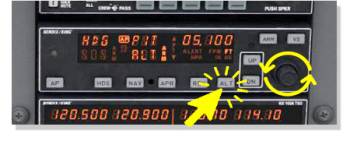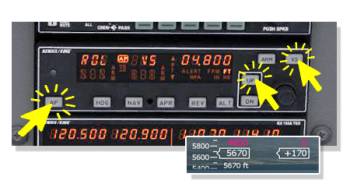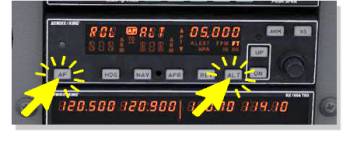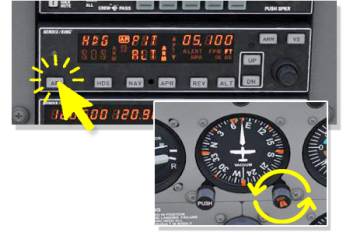This is an old revision of the document!
Table of Contents
Basic Autopilot (Found in Cessna 172 and Baron B58)
General information
Note Autopilot functionality can be different between aircraft. Some of the AP functions are not final in the early access version.
You can control the autopilot by two different ways.
- You can control the autopilot from the cockpit using the mouse and mouse wheel, or with your VR controller (VR Mode). Note - VR motion controls are preliminary and in a basic state. This will be improved over time.
- You can bind autopilot controls to your keyboard keys or controller buttons for convenience (Settings/Controls/Autopilot).
The autopilot can stabilize the heading, airspeed, altitude as well as the vertical speed. The autopilot cannot be switched on/off and will disengage when one of the following limits is exceeded:
- bank angle larger than 60 degrees
- pitch angle larger than 45 degrees
- airspeed less than 1.2 times the stall speed
- when the aircraft is on the ground.
Autopilot modes
WINGS LEVEL (ROL)
In this mode the autopilot will attempt to keep the wings level (ROL)
PITCH ALTITUDE HOLD (PIT)
The Pitch Attitude Hold (PIT) mode allows constant attitude climbs and descends.
AIRSPEED (SPD)
The airspeed mode / auto-throttle will adjust the engine power to keep the selected airspeed. The target airspeed is shown in magenta at the virtual cockpit and can be changed by individually programmed buttons or keys.
HEADING HOLD (HDG)
The heading hold mode can be activated and deactivated by tapping on the heading indicator. The box around the heading will change its color to green to indicate the heading is controlled by the autopilot. If no heading was selected, the current heading will be selected and shown in magenta. The target heading can be changed by tapping the + / – buttons below the heading indicator. Pressing these buttons repeatedly will change the selected heading by 5 degrees. The target heading can be changed while the heading mode is engaged, the autopilot will then turn the aircraft to the selected heading.
ALTITUDE HOLD (ALT)
Hold a constant altitude. This mode is perfect for cruise flight at a constant altitude. Tap the altitude indicator to activate this mode. When engaged, the autopilot will climb / descend to the target altitude and level off. The vertical speed in this phase can be selected by using the + / – buttons below the vertical speed indicator . When the target altitude is changed by tapping the + / – buttons below the altitude indicator, the autopilot will initiate a climb / descend to the new altitude. The vertical speed for this will be the last selected vertical speed, provided it has the right direction. If a descent would be required to reach the new altitude and the last selected vertical speed was a climb at 1000 ft/min, this would be changed to a default of -1500 ft/min and vice versa.
Vertical speed (V/S)
Climb / descend at a constant rate. When engaged, the autopilot will try to climb / descend at the selected vertical speed. If the aircraft cannot climb at the selected vertical speed, it will loose airspeed until the autopilot descends at minimum speed. This mode can be selected by tapping the vertical speed indicator. The v/s mode will override the altitude mode, so this can be used to leave an altitude that was previously held constant by the autopilot. On the other hand, if the altitude mode is active, the vertical speed mode will disengage 500 ft before reaching the target altitude to allow levelling off and avoid crossing a selected altitude.
Two axis stabilization (ROL + ALT)
The easiest way to use the autopilot is the ROL/ALT mode. The ROL mode will be enabled automatically if you start the autopilot via the (AP) button on the autopilot panel.
After that press the (ALT) button on the panel. Now the aircraft will be stabilized automatically.
Heading mode (HDG)
- Click the (AP) button to activate the autopilot
- Click on (HDG) button to activate the Heading Mode. You also will see “HDG” on the panels display
Note - To change your heading manually, turn the heading indicator bug until your new heading is achieved. You can use your mouse wheel to turn the heading bug.

- You can change the altitude by turning the select knob (mouseover and mouse wheel).
- Click on “Arm” to activate the selected height
- Click once again on “ALT” to activate the Pitch, displayed by “PIT”
- Click repeatedly on “UP” or “DN” to select the climb/descend rate
Note - Setting up the autopilot in this way will target the preset height and will hold the flight level automatically. At this point you can change the flight level by pressing the “up” or “down”.
Vertical speed mode (VS)
 The vertical speed (VS) mode allows variable vertical speed climbs and descents.
The vertical speed (VS) mode allows variable vertical speed climbs and descents.
- Click on (AP) to activate the autopilot
- Click on (VS) to activate the vertical speed Mode
- Click on (UP) or (DN) to select vertical speed rate
- Control the rate by the vertical speed indicator or climb rate on your instrument panel
Note - You can now add the heading mode by clicking on (HDG) if preferred. You can control the course via the “HDG” select knob and climb rate with the “UP” or “DN” buttons.
Advanced Autopilot
Note
This section will be improved but this will provide you with basic information related to the newly introduced advanced autopilot features and functionality seen in the latest Aerofly FS2 update
Introduction
We want to give a bit of an overview on the current autopilot setup before getting into more detail about what changed. One important aspect is that there are only two autopilot implementations in Aerofly FS2 currently. There is the basic autopilot that is found in the Cessna 172 and Baron B58 and there is an advanced autopilot which has more features and controls all the airliners: Airbus A320, Boeing B737, Boeing B747, C90GTx King Air, Learjet LJ45 and Dash8-Q400. These airliner-autopilots can be split into three groups: Airbus, Boeing and Bombardier autopilots. This autopilot update only affected the autopilot found in the airliners, the basic autopilot wasn't touched at all.
Airbus (A320)
Changes to the autopilot in the A320
The major concept behind the Airbus auto flight system is to reduce the workload for the pilots. There is a lot of automation happening here in the real world and the plan was to improve the typical Airbus flow. All changes made here make it a lot easier to fly from A to B and require less pilot interaction than before.
- when flight director is set on when on ground and a route has been programmed and starts nearby:
- automatically arm “CLB” and “NAV” so that you can take off and directly engage the autopilot, not touch any autopilot things until you're close to the top of descent.
- when setting the aircraft on the departure runway there are now no remaining things todo to prepare the autopilot:The Cruise altitude is set, flight directors are on, CLB and NAV are armed
- autopilot can land the aircraft automatically when the destination runway has an ILS installed
corrected these lateral modes:
- HDG - heading mode now allows for 360° turns to left or right, depending on how the knob was turned
- NAV - now requires an intercept with the flight plan or a low lateral offset
- added the following lateral modes:
- TRK - selected track over the ground is flown, this corrects for any wind drift
- GA TRK - same as track, track synchronized when go around is initiated
- LOC* - capture mode for the localizer, tries to match the track of the aircraft and the ILS course, then centers localizer deflection
- RWY - takeoff mode (requires ILS to be set to departure runway ILS frequency which should happen automatically but doesn't yet, happens outside the AP)
- RWY TRK - when route is available but the takeoff used RWY localizer steering: at lift off use the runway course only and fly this track.
- ROLLOUT - steers the aircraft towards the ILS localizer center on the ground and also does this in crosswind conditions
- corrected the following vertical modes:
- CLB - managed climb mode does no longer set managed speed to true, also allows for a step climb when the altitude change isn't too big (does softer pitch up and down)
- DES - same as for CLB, now flies with idle thrust and varies speed to stay on profile, maintains around -1000ft/min if below target altitude and maintains managed speed + 20kts (or so) to get back down onto profile
- OP CLB - now independent of speed managed or selected
- OP DES - same as OP CLB
- added the following vertical modes:
- FINAL - uses a vertical altitude offset from flight plan to direct the aircraft down to the runway threshold. Used for non-ILS approaches, e.g. if the runway has no ILS installed.
- EXP DES - expedited descent uses maximum speed and idle thrust to nosedive really quickly. Is very effective when speedbrakes are set
- EXP CLB - pulls the nose up towards the green dot speed and adds full climb thrust to maximize the climb gradient. Very effective if the aircraft speed is already high and altitude has to be gained quickly
- G/S* - captures the glide slope
- FLARE - transitions from glide slope to a touch down control, reduces rate of descent and increases the pitch to set the aircraft onto the runway gently
- ROLLOUT - reduces pitch after touchdown
- SRS - speed reference system: Uses V2 + 10kts as a target speed and controls the pitch of the aircraft after lift off or in a low altitude go around. Engages automatically if you set takeoff thrust with flight directors on
- FPA - flight path angle: commands the aircraft to climb or descent at a selected angle. This is very helpful during a descent when you plan to reduce speed. The angle of the descent is maintained even if the speed is increased or decreased, this is what the vertical speed can't to
- ALT* captures the selected altitude
- ALT CRZ - soft altitude hold mode at cruise altitude
- added the following autothrust modes:
- SPEED - we had that before, now it allows to select a speed at any time without affecting the vertical mode
- MACH - after automatic or manual crossover at high altitudes to Mach-Numbers this mode controls the speed in terms of Mach number not indicated airspeed
- IDLE - there are now two types: one that remains idle and one that automatically jumps in during the idle
- DES in case the speed gets too low.
- CLB - reduced thrust is used now.
- manual thrust modes: MAN FLX, MAN TOGA, MAN LVR (forgot the name already, activates between detents)
- A.FLOOR - alpha floor engages automatically whenever the aircraft is forced into a stall due to high angles of attack. Automatically sets full thrust as quickly as possible to be able to recover the low airspeed
- TOGA LK - engages when the angle of attack is reduced but the pilot did not move the thrust levers yet.
- Disengages as soon as the levers are moved a bit.
- managed speed behavior also changed:
- 250kts below 10,000ft
- climb, cruise and descent phases
- descent speed range
- approach phase: ground speed mini (flap and slat retraction speed), automatically engages approach phase at deceleration point or when LOC captures (the latter is a hack while FMS isn't programmed)
- added thrust locked when auto thrust is set off with the A/THR pushbutton
- added thrust command of the auto thrust system is clamped between idle and current thrust lever angle
- added auto thrust is set off when levers pulled to idle
- added auto thrust arms when levers pushed beyond CLB
- added auto thrust arms on ground when flight directors are active and levers are moved to FLX/MCT or TOGA
- added auto thrust engages when previously armed and levers advanced from IDLE to some positive value or when levers are moved into CLB detent from above (usually after takeoff)
- added flashing “LVR CLB” message to PFD to demand the pilot to set levers to climb to engage the auto thrust system, also added ECAM message that explains this in text format
- added boxes around new modes
- added combined modes “LAND”, “FLARE” and “ROLLOUT” to PFD
- added DH is preset as soon as ILS approach is engaged.
- added mode reversions: when route is lost or NAV mode is disengaged managed CLB changes to OP CLB and DES changes to V/S or FPA. Audible tripple click added
- added ground speed mini principle to the managed airspeed: when flaps are 0 speed target remains above green dot speed, when flaps are at 1 speed doesn't drop below -S speed, flaps 2 or 3: above -F speed
- added auto thrust will not allow speed to drop below VLS or above Vmax in the current configuration (e.g. speedbrakes extended) if auto thrust is controlling SPEED
- corrected minimum and maximum select-able speed, min/max selectable altitude and VS or FPA
Fly-By-Wire changes
- increased roll rate
- improved turn coordination
- added protections:
- angle of attack protection: automatic trimming aft is prevented, actively reduces angle of attack to alpha-protection, at full aft stick the angle of attack no longer be able to exceed the stall angle, auto thrust engages at high angle of attack and commands full thrust
- bank protection: depending on overspeed or stall conditions maximum bank angle is reduced from 67° to 45/33° with fully deflected side stick. Will return to 33° when released or 0° when in overspeed or stall conditions
- high and low pitch protections changed, high pitch protection now dynamic and only 25° when speed is below VLS
- overspeed protection: aircraft now pitches up automatically and prevents any nose down command by the pilo
- added: trim resets after touchdown. This has to be softened yet, known issue
Other additions to the A320
- moving pushbuttons
- automatic spoiler retraction in high angles of attack
- added slat retraction inhibited at high angles of attack
- reduced drag
- increased aircraft mass to almost 60t (still below max landing weight)
- corrected v-speeds for increased takeoff-mass of 60t
- changed landing gear levers is locked on the ground
- changed radar altitude callouts now quieter
- corrected FCU display, e.g. dashing values after 10 or 45 seconds
- fixed baro-pull knobs, now push and pull
- fixed auto-brake not on MAX in takeoff configuration
- added throttle detents
Display changes in the A320


